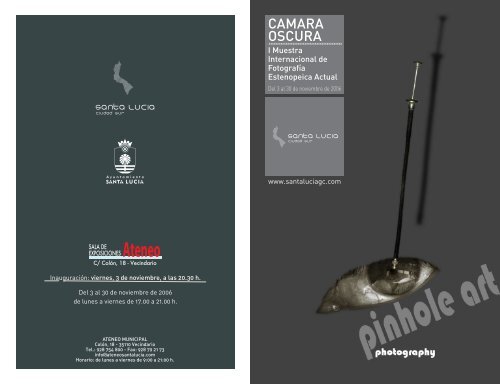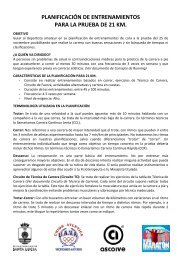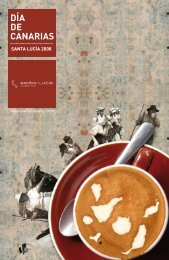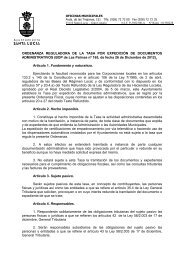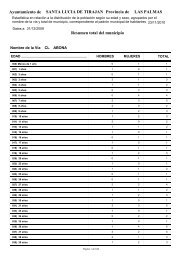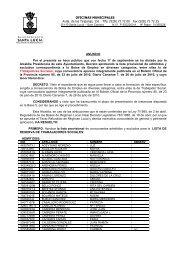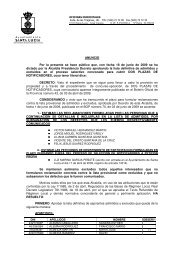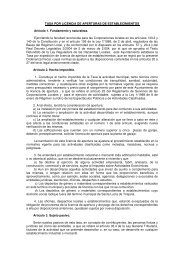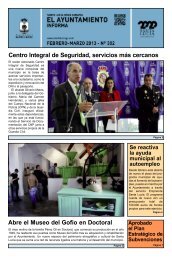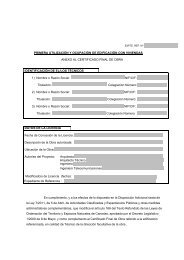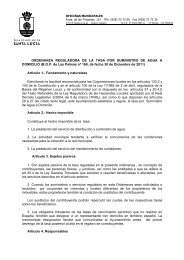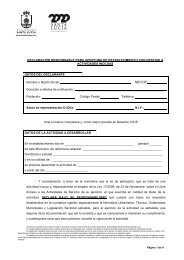Catalogo de la exposición.
Catalogo de la exposición.
Catalogo de la exposición.
Create successful ePaper yourself
Turn your PDF publications into a flip-book with our unique Google optimized e-Paper software.
CAMARAOSCURAxxxxxxxxxxxxxxxxxxxxxxxxxxxxxxxxxxxxxxxxxxxI MuestraInternacional <strong>de</strong>FotografíaEstenopeica ActualDel 3 al 30 <strong>de</strong> noviembre <strong>de</strong> 2006www.santaluciagc.comInauguración: viernes, 3 <strong>de</strong> noviembre, a <strong>la</strong>s 20.30 h.Del 3 al 30 <strong>de</strong> noviembre <strong>de</strong> 2006<strong>de</strong> lunes a viernes <strong>de</strong> 17.00 a 21.00 h.ATENEO MUNICIPALColón, 18 - 35110 VecindarioTel.: 928 754 800 - Fax: 928 79 21 73info@ateneosantalucia.comHorario: <strong>de</strong> lunes a viernes <strong>de</strong> 9:00 a 21:00 h.
“Cautivados por <strong>la</strong>s posibilida<strong>de</strong>s <strong>de</strong>simplicidad y lentitud <strong>de</strong>s<strong>de</strong> <strong>la</strong> <strong>exposición</strong>hasta <strong>la</strong> impresión, obtener cada imagenes como un acto <strong>de</strong> fe, <strong>de</strong> química y <strong>de</strong>magia”“Captivated by the possibilities of simplicityand slowness from exposure to print, makingeach image is an act of faith, chemistry, andmagic.Katie Cooke
Anastasia Medve<strong>de</strong>vaRusiawww.silverimage.ruAnastasia Medve<strong>de</strong>va nació y vive en Moscú, Rusia. Es un miembro <strong>de</strong> <strong>la</strong>Unión <strong>de</strong> Fotógrafos <strong>de</strong> Arte <strong>de</strong> Rusia.Según <strong>la</strong>s pa<strong>la</strong>bras <strong>de</strong> Anais Nin “No vemos el mundo como es, lo vemoscomo somos nosotros”. Anastasia explora su mundo interior mediante <strong>la</strong>fotografía. La técnica <strong>de</strong>l agujero <strong>de</strong> alfiler permite proyectar su visión interiorhacia el mundo. Con <strong>la</strong>rgas exposiciones pue<strong>de</strong> ver y sentir el movimiento <strong>de</strong>ltiempo. El proceso <strong>de</strong> <strong>la</strong> luz sustituye a una meditación.Anastasia Medve<strong>de</strong>va was born and livesin Moscow, Russia.She is a member of Union of ArtPhotographers of Russia.According with words of Anais Nin "Wedo not see the world as it is. We see the worldas we are" Anastasia explores her internalworld with photography. Pinhole permits toproject her inner vision into the world. Withlong exposures she can see and feel timemovement. Lith process substitute for ameditation.Anastasia Medve<strong>de</strong>vaStates. Study III - 2005
Daniel ZrihenIsraelwww.zrihen.free.fr/dz.htmlCurriculum1969 Arrived to Israel from Canary Is<strong>la</strong>nds.1971 - 1975 Israeli Army.1978 - 1980 Completed Advanced Study in Photography - The "NeriBloomfield School of Design".1981 - 1995 Teaching photography in "The Jordan Valley College".Guest Artist in : "Bezalel Aca<strong>de</strong>my" - Jerusalem.Work-Shops about : The Zone System. Multigra<strong>de</strong> Printing &Fine Print Photography.Work-Shops in Tel-Aviv : Cibachrome Print. The Zone System.1995 - 1997 Teaching in The "Neri Bloomfield" School Photography &Studio Photography.Exhibitions1983 Museum "Ury & Ramy" - Jordan Valley.1983 "Bet Yad Labanim" - Tiberias.1985 Matnas - Menahamia - Jordan Valley.1989 Kibbutz Degania B'.1989 Kibbutz Afikim.1990 Centro <strong>de</strong> Cultura - Canary Is<strong>la</strong>nds "The Jordan RiverBaptistmal Center".1992 "Wizo" Haifa.1993 Tel-Aviv "Tzavta".1980 Neri Bloomfield , Haifa.1985 Israel Photography - Club Prensa Canaria - Canary Is<strong>la</strong>nds.1992 "The Ethiopians" - The Jordan Valley College. B&WDocumentary photography.1995 "Oxymoron" - Canary Is<strong>la</strong>nds.Daniel ZrihenMural<strong>la</strong> en sepiaPrivate CollectionsCanary Is<strong>la</strong>nds, France, Spain, Israel, Italy.
David CugnascaEE. UU.Usando una caja <strong>de</strong> ma<strong>de</strong>ra embisagrada, una caja <strong>de</strong> cartón e incluso unbuzón <strong>de</strong> plástico negro, así es como comencé a apren<strong>de</strong>r a hacer cámaras <strong>de</strong>agujero <strong>de</strong> alfiler e imágenes fotográficas con esta técnica. Ésas eran misprimeras cámaras artesanales. Hace años me enseñaron que se pue<strong>de</strong> haceruna cámara con cualquier recipiente estrecho y ligero haciéndole un pequeñísimoagujero centrado en una pieza <strong>de</strong> <strong>la</strong>tón. Un pedazo <strong>de</strong> cinta negra actúa comoun obturador mientras un papel sensible a <strong>la</strong> luz colocado cuidadosamente<strong>de</strong>ntro <strong>de</strong> <strong>la</strong> cámara es expuesto a <strong>la</strong> luz cuando <strong>la</strong> cinta negra se retira <strong>de</strong><strong>la</strong>gujero y se vuelve a colocar. En términos técnicos, aprendí cómo construir mipropia cámara y el método <strong>de</strong> usar papel fotosensible para crear negativos<strong>de</strong>ntro <strong>de</strong> <strong>la</strong> cámara.El proceso <strong>de</strong> agujero <strong>de</strong> alfiler <strong>de</strong>safió y cambió totalmente mi punto <strong>de</strong>vista sobre <strong>la</strong> imaginería artística <strong>de</strong> <strong>la</strong> fotografía. Aquí, en mi mundo <strong>de</strong> agujero<strong>de</strong> alfiler, no hay lentes o exposiciones automáticas. Nada es mecánico. Es unmundo <strong>de</strong> prueba, error y ocasión. Ésta es una forma <strong>de</strong> fotografía que vuelvea lo básico. Es don<strong>de</strong> todo comenzó hace cientos <strong>de</strong> años.David CugnascaCaroleUsing a woo<strong>de</strong>n hinged box, a cardboard box and evena b<strong>la</strong>ck p<strong>la</strong>stic mailbox, that is how I began to learn how tomake pinhole cameras and pinhole photographic images. Thosewere my first homema<strong>de</strong> cameras. Years ago I was taught andshown that you can make a camera out of any light tightcontainer with a tiny pin hole, centered in a piece of tin. Apiece of b<strong>la</strong>ck tape acts as a shutter while light-sensitive papercarefully p<strong>la</strong>ced insi<strong>de</strong> the “camera” is exposed to the lightwhen the b<strong>la</strong>ck tape is pulled away from the pinhole and thenp<strong>la</strong>ced back. In terms of technique, I learned how to buildmy own cameras and the method of using photosensitive paperto create negatives insi<strong>de</strong> my camera.The pinhole process challenged and changed my total viewof the artistic imagery of photography. Here, in my pinholeworld, there are no lenses or automatic exposures. Nothing ismechanical. It is a world of trial and error and chance. Thisis a form of photography that goes back to basics. It is whereit all began hundreds of years ago.
Henrieke I. StreckerAlemaniawww.pinhole-photography.<strong>de</strong>Permaneciendo en un lugar, emergiendo <strong>de</strong> <strong>la</strong> locura <strong>de</strong> <strong>la</strong> prisa diaria,sin posibilidad ni esperanza <strong>de</strong> llegar, permite que una percepción <strong>de</strong> lo queya ha ocurrido surja y vuelva a surgir <strong>de</strong> nuevo. Emanarán <strong>de</strong> esta prisa cuentos,gestos amenazados <strong>de</strong> hundirse en esta rapi<strong>de</strong>z, casi cubiertos por <strong>la</strong> misma…Quiero dar un re<strong>la</strong>to <strong>de</strong> estos pequeños movimientos, atmósferas, no sóloun momento, “pintando un cuadro realista”, según un informe, pero <strong>la</strong>experiencia <strong>de</strong> <strong>la</strong> situación, en <strong>la</strong> que <strong>la</strong> toma se malogró.Especialmente en <strong>la</strong> serie <strong>de</strong> retratos pue<strong>de</strong>s observar lo que ocurre,cuando <strong>la</strong> gente es forzada a esperar, qué huel<strong>la</strong>s quedan atrás en este período<strong>de</strong> tiempo. Mientras nuestros antepasados –hace más <strong>de</strong> cien años- se sentaronrígidamente, apareciendo <strong>de</strong> tal manera, preñados <strong>de</strong> significado, <strong>de</strong><strong>la</strong>nte <strong>de</strong><strong>la</strong> cámara, encerrados en horrorosas maquinarias para evitar cualquiermovimiento durante esas <strong>la</strong>rgas exposiciones, tomo ventaja <strong>de</strong> este‘acontecimiento’ para dar con estos leves gestos, para pintar lo que suce<strong>de</strong><strong>de</strong>trás <strong>de</strong> <strong>la</strong>s poses obvias – algo <strong>de</strong> lo que somos conscientes-.Remaining at a p<strong>la</strong>ce, emerging from the usual everydaymad rush, which has no chance, no hope of arrival, permitsa perception of what has already happened to come up onceand again. Tales will step out of this rush, gestures threatenedto be drowned by this quickness, almost covered by it.I want to give an account of these small movements,atmospheres, not an iso<strong>la</strong>ted moment, "painting a realisticpicture", according to a report, but the experience of thesituation, in which the taking was un<strong>de</strong>rgone.Especially in the series of portraits you can observe whatis going on, when people are forced to wait, which traces areleft behind in this period of time. While our forefathers - morethan a hundred years ago - sat stiffly, appearing thereforepregnant with meaning, in front of the camera, hemmed indreadful machineries in or<strong>de</strong>r to avoid any move during theselong exposures, I take advantage of this factum to track downthese slight gestures, to paint the happenings behind the obviousposes - something we hardly become aware of.Henrieke I. Streckers/t
UNA REFLEXIÓN SOBRE EL ARTE POBRE, CONTRATODOS LOS MITOS, Y A FAVOR DE LA AUTOCRÍTICALa técnica “pinhole” –<strong>de</strong> agujero <strong>de</strong> alfiler-, investigada por un reducidocolectivo <strong>de</strong> nuestra sociedad fotográfica, fue base <strong>de</strong> trabajo para crear unángulo <strong>de</strong> visión y para <strong>de</strong>stacar <strong>de</strong> forma diferenciada <strong>la</strong> arquitectura Gaudiniana,tantísimas veces reproducida.Gaudí nos dijo “para hacer bien <strong>la</strong>s cosas, es necesario primero, el amorhacia el<strong>la</strong>s y segundo, <strong>la</strong> técnica.”Quisiera tras<strong>la</strong>dar parte <strong>de</strong> este mensaje, como reflexión sobre <strong>la</strong> situaciónen que está inmersa <strong>la</strong> línea y corrientes <strong>de</strong> actuación <strong>de</strong> nuestro mundo, mall<strong>la</strong>mado “amateur”.Nuestra producción fotográfica, <strong>de</strong>s<strong>de</strong> <strong>la</strong> post-guerra, ha sido esencialmenteendogámica, p<strong>la</strong>gada/alimentada constantemente <strong>de</strong> todo tipo <strong>de</strong> novedadque nos cautiva. Pero nuestro mayor pecado, <strong>de</strong>l que <strong>de</strong>sgraciadamente muchossomos culpables, es <strong>de</strong> haber creído que <strong>la</strong> estética, <strong>la</strong> perfección o <strong>la</strong> bellezason lo único esencial y motivo <strong>de</strong> mérito.La belleza, <strong>la</strong> estética, <strong>la</strong> perfección...Sinceramente, hoy por hoy, so<strong>la</strong>mente el contenido, <strong>la</strong> inquietud, <strong>la</strong>investigación, el trabajo, <strong>la</strong> i<strong>de</strong>a, el esfuerzo, <strong>la</strong> libertad, es lo único que meinteresa <strong>de</strong>l arte. Y en mi medio fotográfico, prefiero <strong>la</strong> verdad que buscanManuel Barranco Martos, Joel-Peter Witkin o Gilles Berquet, a cuantos utilizanel ma<strong>la</strong>barismo <strong>de</strong> <strong>la</strong> trampa <strong>de</strong>l p<strong>la</strong>cebo <strong>de</strong> <strong>la</strong> perfección irreflexiva y estéril...Véase un ejemplo, en <strong>de</strong>snudo, tiene más impacto <strong>de</strong> contenido, unafotografía tomada con cámara sencil<strong>la</strong>, o incluso compacta, que otra realizadacon técnicas <strong>de</strong> suavizado y <strong>de</strong> “g<strong>la</strong>mour”... ¿Por qué? Porque sencil<strong>la</strong>mente,un exceso <strong>de</strong> técnica “enfría” este contenido hasta neutralizar su mensaje...Acaso ¿en reportaje pue<strong>de</strong>n superarse <strong>la</strong>s obras <strong>de</strong> Cartier Bresson? Su secreto:en <strong>la</strong> mayoría <strong>de</strong> veces, es su limpieza, austeridad y espontaneidad, inclusocon el elogio <strong>de</strong> encuadres imperfectos. “El espíritu más elevado humano esescrupuloso, mira muy <strong>de</strong> cerca, rechaza todo aquello que se aparta <strong>de</strong> <strong>la</strong>Verdad”, Marcel Proust.El movimiento <strong>de</strong> <strong>la</strong> fotografía pobre, que resurge, tiene cientos <strong>de</strong> miles<strong>de</strong> a<strong>de</strong>ptos en todo el mundo como rechazo y respuesta a un abuso <strong>de</strong> tecnología,<strong>de</strong> comodidad, <strong>de</strong> irreflexión. Especialmente en una disciplina como <strong>la</strong> nuestra,<strong>de</strong> <strong>la</strong> que uno es consciente que existen personas que <strong>de</strong>sconocen incluso elprincipio <strong>de</strong> <strong>la</strong> cámara oscura como elemento principal para <strong>la</strong> creación <strong>de</strong>imágenes.Gaudí, también dijo: “LAS FORMAS EXPRESADAS CON SENCILLEZ POSEENMÁS GRANDEZA”Josep Maria Ribas i ProusBarcelona - EspañaJ. M. Ribas i ProusEl abanicoA REFLECTION ON THE POOR ART, AGAINST ALL MYTHSAND IN FAVOUR OF SELF-CRITICISMThe “pinhole” technique, studied by a short collective of our photographic society, was the basisof work to create an angle of vision and highlight Gaudí’s architecture, so many times reproduced indifferent ways.Gaudí once said “To do things well, firstly, it is necessary the love for them and secondly, thetechnique.”I would like to transfer part of this message, as a reflection about the situation in which our world,badly called “amateur”, is immersed, with its line and current performance.Our photographic production, since the post-war, has essentially been endogamic, constantly fedwith all kinds of novelty which captivate us. But our main sin, for which unfortunately many of usare to b<strong>la</strong>me, is that of having thought that aesthetics, perfection or beauty are the only, essential andworth-while thing.Beauty, aesthetics, perfection,…Honestly speaking, nowadays only the content, the concerns, research, work, i<strong>de</strong>as, effort andfreedom are the only things which are of interest for me in art. And in my photographic area I preferthe truth that Manuel Barranco Martos, Joel-Peter Witkin, o Gilles Berquet seek, rather than thosewho use the ba<strong>la</strong>ncing arts and the p<strong>la</strong>cebo of rash, sterile perfection.Take as an example a nu<strong>de</strong>, a picture taken with a simple or even with a compact camera, itscontent has more impact than another one taken with softening and “g<strong>la</strong>mour” techniques… Why?Because simply, an excess of technique “cools down” this content until it neutralizes its message… Isit by any chance possible to exceed Cartier Bresson’s work on illustrated feature? His secret: in mostcases it is his cleanliness, his austerity and spontaneity, even with the praise of imperfect framings. “Thehighest human spirit is scrupulous, watches very close and rejects all that gets far away from the truth”,Marcel Proust.The movement of poor photography, which is re-emerging, has hundreds of thousands of a<strong>de</strong>ptsin the whole world, as a rejection and as an answer to an abuse of technology, of commodity, of rashness.Especially in a discipline, like ours, which is so unknown to many people, who are not even aware ofthe principle of the dark camera as a main element to create images.Gaudí also said: “The forms expressed simply have more greatness”.Josep Maria Ribas i Prous
Joaquín CasadoEspañaLa fotografía <strong>de</strong> Joaquín Casado se enmarca <strong>de</strong>ntro <strong>de</strong> lo que podíamos<strong>de</strong>nominar “fotografía <strong>de</strong> investigación” en el campo <strong>de</strong> <strong>la</strong> fotografía estenopeica.Es uno <strong>de</strong> los diseñadores y constructores <strong>de</strong> cámaras estenopeicas conmas prestigio internacional entre los fotógrafos y galeristas que utilizamoseste medio <strong>de</strong> expresión para nuestra fotografía <strong>de</strong> autor. En su web sitewww.casadopinhole.net po<strong>de</strong>mos observar sus magníficos trabajos fotográficoscomo los mo<strong>de</strong>los exclusivos y con una terminación impecable <strong>de</strong> sus cámarasestenopeicas. Investigador incansable, nos muestra sus últimos avances en<strong>la</strong> captura con doble slit y <strong>la</strong>s imágenes panorámicas <strong>de</strong> <strong>la</strong> “ovnipan”- unacámara <strong>de</strong> 6 estenopos y 360º- y como no, <strong>de</strong>stacar su <strong>la</strong>bor con <strong>la</strong>s cámaras“anamórficas” en sus trabajos <strong>de</strong> <strong>la</strong>s “Torres” don<strong>de</strong> consigue una <strong>de</strong>formación<strong>de</strong> <strong>la</strong> perpectiva arquitectónica totalmente contro<strong>la</strong>da don<strong>de</strong> nos sumerge<strong>de</strong>ntro <strong>de</strong>l más puro surrealismo fotográfico.Joaquin Casado’s photography can be c<strong>la</strong>ssifiedamong what we could call “research photography”in the area of stenopeic photography.He is one of the internationally best-known<strong>de</strong>signers and buil<strong>de</strong>rs of stenopeic cameras amongphotographers and gallery owners who use this meansof expression for our author’s photography. In hiswebsite www.casadopinhole.net we can observe hisphotographic work such as the exclusive mo<strong>de</strong>ls andwith an impeccable finish of his stenopeic cameras.As a tireless researcher, he shows us his <strong>la</strong>st progressesin double slit shots and the panoramic views of the“ovnipan”- a camera with 6 stenopes and 360º- andof course, we must highlight his work with theanamorfic cameras used to do his work of the“Towers”, where he achieves a totally controlled<strong>de</strong>formation of the architectural perspective, wherehe immerses us into the purest photographic surrealism.Joaquín Casados/t
Katie CookeEscociawww.slowlight.net/blog/Des<strong>de</strong> que comencé <strong>la</strong> fotografía <strong>de</strong> agujero <strong>de</strong> alfiler, cada vez me sientomás atraída por este proceso, con cada lámina <strong>de</strong> pelícu<strong>la</strong>, cautivada por <strong>la</strong>sposibilida<strong>de</strong>s <strong>de</strong> simplicidad y lentitud. Con retratos <strong>de</strong> <strong>la</strong>rga <strong>exposición</strong>, nopuedo capturar un momento entre expresiones conge<strong>la</strong>do en una fracción <strong>de</strong>segundo, en vez <strong>de</strong> ello hago una foto <strong>de</strong> una persona en el tiempo, <strong>de</strong>scubriendoqué movimientos y variaciones <strong>de</strong>jan una huel<strong>la</strong> y cuáles se <strong>de</strong>svanecen, ycómo éstos cambian <strong>la</strong> percepción <strong>de</strong> <strong>la</strong> persona fotografiada.Usando una caja vacía sin mecanismo o lente, mi fotografía es una lentay tranqui<strong>la</strong> conversación entre <strong>la</strong> cámara y <strong>la</strong> persona que aguarda. Des<strong>de</strong> <strong>la</strong><strong>exposición</strong> hasta <strong>la</strong> impresión, obtener cada imagen es como un acto <strong>de</strong> fe, <strong>de</strong>química y <strong>de</strong> magia.Las imágenes incluidas en esta exhibición pertenecen a una serie mayorl<strong>la</strong>mada “Acto <strong>de</strong> ba<strong>la</strong>nceo”, comenzando <strong>de</strong>s<strong>de</strong> <strong>la</strong>s i<strong>de</strong>as <strong>de</strong> quietud, movilidady tiempo. Esto es un trabajo en curso, que explora <strong>la</strong>s i<strong>de</strong>as y limitacionesprácticas <strong>de</strong>l hecho <strong>de</strong> per<strong>de</strong>r y luego volver a ganar mi habilidad para caminary permanecer <strong>de</strong> pie.Since I began pinhole photography, I've fallenincreasingly in love with it with every sheet of film, captivatedby the possibilities of simplicity and slowness. With longexposureportraits, I can't capture the split-second freeze ofa moment between expressions, instead I make a pictureof a person across time, discovering which movements andvariations leave a trace, and which vanish, and how thesechange the perception of the person portrayed.Using an empty box with no mechanics or lens, myphotography is a slow, quiet conversation between cameraand sitter. From exposure to print, making each image isan act of faith, chemistry, and magic.The images inclu<strong>de</strong>d in this exhibition are from a<strong>la</strong>rger series called Ba<strong>la</strong>ncing Act, starting from i<strong>de</strong>as ofstillness, mobility and time. This is an ongoing work,exploring the i<strong>de</strong>as and practical limitations of losing, andthen regaining my ability to walk and stand.Katie CookeSelf Portrait, from ba<strong>la</strong>ncing act
DARK CAMERA: ART AND PHOTOGRAPHYNowadays the stenopeic photography is a highly topicalsubject for several reasons since the mid-sixties when someartists with no connection started to experiment with thepinhole technique. Paolo Gioli (Italy) is maybe one of themain exponents together with others such as Gottfried Jäger(Germany), David Lebe, Franco Salmoiraghi, Wiley San<strong>de</strong>rsonand Eric Renner in the U.S.A.Many of these artists coinci<strong>de</strong>d by working on multiplepin head technique at a time. Wiley San<strong>de</strong>rson was photographyteacher at Georgia University and his lessons on stenopeicphotography ranged from 1953 to 1988. During that timehis stu<strong>de</strong>nts built 4356 stenopeic cameras. If we take thehistory of photography and especially what is re<strong>la</strong>ted to thestenopeic technique into consi<strong>de</strong>ration, we can gather thatalthough this technique has been somewhat ostracized frommost photography circles, it has never gone unnoticed. Withthe arrival of new technologies we have verified that thisphotographic technique is still in force, not only has its usebeen promoted in the world of art, but also in commercialphotography and fashion, due to the attractive mysteriousaesthetics which it projects.The present trend is the raising <strong>de</strong>mand of this techniquein schools of both artistic and professional photography.Although this artistic process is the principle of more than150 years of photography, as you can see in this exhibitionmagic and the post-process infinite creative possibilities <strong>de</strong>finitelyframe the stenopeic photography as a mo<strong>de</strong>rn alternativetechnique with a promising future.CÁMARA OSCURA: ARTE Y FOTOGRAFÍAHoy en día <strong>la</strong> fotografía estenopeica está <strong>de</strong> actualidad por múltiplesrazones <strong>de</strong>s<strong>de</strong> que a mediados <strong>de</strong> los años setenta varios artistas sin conexiónalguna comenzaron a experimentar con <strong>la</strong> técnica <strong>de</strong>l agujero <strong>de</strong> alfiler. Po<strong>de</strong>mos<strong>de</strong>stacar a Paolo Gioli (Italia) como uno <strong>de</strong> los principales exponentes y a otroscomo Gottfried Jäger (Alemania),David Lebe, Franco Salmoiraghi, WileySan<strong>de</strong>rson y Eric Renner en los E.E.U.U.Coinci<strong>de</strong>ntemente, muchos <strong>de</strong> estos artistas trabajaban con agujeros <strong>de</strong>alfiler múltiples. Wiley San<strong>de</strong>rson era profesor <strong>de</strong> fotografía en <strong>la</strong> universidad<strong>de</strong> Georgia y sus enseñanzas sobre fotografía estenopeica abarcaron un período<strong>de</strong>s<strong>de</strong> 1953 a 1988. Durante ese tiempo sus estudiantes construyeron 4356cámaras estenopeicas. Si observamos un poco <strong>la</strong> historia <strong>de</strong> <strong>la</strong> fotografía y enlo que se refiere a <strong>la</strong> técnica estenopeica po<strong>de</strong>mos observar que nunca hapasado <strong>de</strong>sapercibido aunque se haya notado cierta marginación en <strong>la</strong> mayoría<strong>de</strong> los círculos fotográficos. Con <strong>la</strong> llegada <strong>de</strong> <strong>la</strong>s nuevas tecnologías hemosconstatado que esta técnica fotográfica sigue vigente y se ha potenciado el uso<strong>de</strong> <strong>la</strong> misma no solo en el mundo <strong>de</strong>l arte, también en <strong>la</strong> fotografía publicitariay <strong>la</strong> moda, por <strong>la</strong> estética misteriosa y atractiva que proyecta.La trayectoria actual es <strong>la</strong> <strong>de</strong>manda creciente <strong>de</strong> esta técnica en escue<strong>la</strong>s<strong>de</strong> fotografía artística y <strong>de</strong> profesionales <strong>de</strong> <strong>la</strong> misma.Aunque este procedimiento artístico es <strong>la</strong> base o principio <strong>de</strong> más <strong>de</strong> 150años <strong>de</strong> fotografía, como pue<strong>de</strong>n observar en esta muestra <strong>la</strong> magia y <strong>la</strong>sinfinitas posibilida<strong>de</strong>s creativas post-proceso enmarcan <strong>de</strong>finitivamente a <strong>la</strong>fotografía estenopeica como técnica alternativa <strong>de</strong> actualidad y con un futuroprometedor.Ricardo Montes<strong>de</strong>oca


